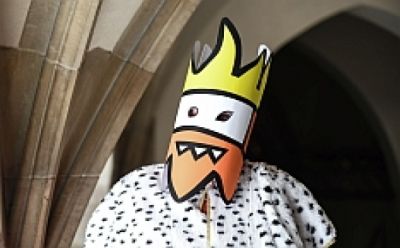Comics have come a long way since they were introduced in the late 19th century. Over the decades, comic strips and books (or graphic novels) became more sophisticated, pushing and redefining artistic and narrative boundaries. Years ago, Petr Litoš - a graduate of CU’s Faculty of Mathematics & Physics – co-founded comic book publisher CREW which is a powerhouse on the Czech market today. From superheroes to manga, he says, comics are here to stay.
What was the first comic you remember seeing?
Probably Čtyřlístek. When I was a kid, I lived one floor below the comic scriptwriter Ljuba Štíplová and I would occasionally get copies. She was brilliant and her catchphrases from the series are legendary today.
Is that when your love of comics began?
I always had a thing for computers and science fiction literature. Under totalitarianism, comics kind of went hand-in-hand with science fiction. There were various events where people from both genres overlapped. You had the writer Ondřej Neff, who used to bring comics from France, which is still a clear leader in Europe today. He was also a great friend and promoter of the cartoonist Kája Saudek, who was also a sci-fi fan. Mostly I got into comics through science fiction.
You started your first publishing house, Gryf, with your friends from the sci-fi club.
That was primarily devoted to philosophy at first. We published Nietzsche, Aristotle, Leonardo da Vinci, thinkers like that. Those were the days when we not only printed the books, but then we also delivered them to the bookstores ourselves in backpacks (smiles). I am talking about the year 1992, when I was fresh out of high school…
You continued your education at the Faculty of Mathematics and Physics of Charles University. You enrolled because of another passion, programming?
I had already begun programming in high school. My school, Gymnasium U Libeňského zámku, had probably the best equipped computer room at that time. The headmaster had managed to get several MZ-800 computers from Sharp besides a big computer from what had been East Germany. At that time, our high school had the hallmark of being the best place to learn programming, with people there who knew how to do it.
Did your studies at CU meet your expectations?
I was happy that I was able to avoid physics, which I never really enjoyed. I was grateful for the combination of computer science and mathematics. And what I appreciated about the faculty was that it gave me a general overview, albeit sometimes things were trickier. What I mean is, you had to learn a number of marginal things that you didn’t use in practice. However, in retrospect I see it as a benefit.
What did you do after graduation?
I already started programming professionally during school. Sometime during my second year I programmed systems for the microbiology laboratory at Na Homolce Hospital. The chief physician Vlastimil Jindrák and Dr Václav Vaniš knew exactly what they wanted. We were working with a lot of live data, and even with the help of the software I was working on, we managed to do amazing things; for example, it helped in reducing the consumption of antibiotics by as much as half. Dr Jindrak used the data to give lectures around the world and many scientific papers came out of it.
The idea of starting a publishing house originated with your classmates from CU?
With completely different people I met through the science fiction community. We kept saying it would be cool to publish comics… and gradually a group of people emerged who were just naive enough to actually try.
You and these companions built the leader on the Czech market. How many titles a year are currently published under the CREW brand?
It’s close to 230. Comic books dominate but we also do other publications and print runs. We do comics from game worlds (like World of Warcraft, The Witcher, Cyberpunk 2077) and together with the Ostrava publishing house Fantom Print we published several so-called “lorebooks” from these worlds. These are basically books that describe more about the different settings; you learn what deities they have and the worlds they inhabit. It’s kind of closer to an encyclopaedia. We’ve even published two World of Warcraft cookbooks!
Is it still true that the most bankable characters in comics is Bart Simpson?
For us, yes, but it’s already being rivalled in some ways by some manga, comics from Japan, and also Pokémon, which is the most valuable license worldwide at the moment. They made three billion dollars in royalties last year alone – from comics, toys, books…
Besides Bart Simpson and Garfield, what are some of your other heavy hitters?
Definitely Japanese manga, and comics related to blockbuster TV series, like Stranger Things or The Witcher, which have huge audiences. The interesting thing about Stranger Things is that in the series, you have a character that disappears for most of the story and is somewhere in a separate reality. It’s only after a while that he returns and narratively you are in the dark about where he was and what he experienced. And that’s what the graphic novel is about. I think that’s a big added value of comics when it’s not just an adaptation. With The Witcher, again, it’s about original stories. In the event what author Andrzej Sapkowski wrote or what you can play in the games isn’t enough for you, you’ll discover even more adventures in the comics.
I’ve read about the pitfalls of your efforts to acquire the rights to Japanese manga. It doesn’t sound easy…
You have to be patient when working with the Japanese: they have a lot of time for everything, so to speak. Whereas Europeans and Americans are all about getting down to business when there is a common ground or incentive, the Japanese will say, “Fine, but let’s get to know each other better first.” And then you exchange emails with them half a year, maybe even a year, and learn about how they went tuna fishing and you tell them about how you vacationed in the Giant Mountains. When a year goes by and you want to get back to business, maybe the person who was in charge has since been replaced and is no longer there – that really happened to me! There are titles that I have continuously applied for over ten years!
Is it common for an author to illustrate their story or is that more of an exception?
It’s not that unusual. In Europe it’s quite common, in America and Japan it’s less, maybe half. Having the talent for both is not a given. The European comics industry is very author-driven, which is not to say that writers aren’t under deadlines but the biggest names have more freedom and can spend more time creating. In America, 22 pages have to come out every month to get a new comic on the shelves on time. And at that point, you’re already putting the author under pressure. There’s a division of labour, which I don’t think is a bad thing: the American writer writes the story, the artist draws the story in pencil, he or someone else outlines and inks it, someone else adds the colours – often there are two colourists – and someone else adds the letters…
What about in Japan?
There, as an author you turn in a whole chapter once a week or once a fortnight, and you’re expected to turn in something like 15 or 20 pages. It may be signed by one person, but in reality it’s a team of as many as 20 people! It’s not uncommon for the publishing company to rent a large apartment and have them all live together so that they have maximum time to work. The author basically just sketches it out, then there’s a specialist who just draws buildings, another who specialises in cars, someone who draws rain, and so on… In Japan, magazines are published in the millions of copies, where there are, for example, 20 chapters of different stories, and every week the readers rate what they like and don’t like. And if there’s something they don’t like, the publisher tells the author, “You have three more chapters, then wrap it up.” And instead they put out something new with potential.
That said, if something gets a lot of attention, the story can swell to 700 chapters! At that point, the author’s stuck with it. We once wanted to fly a Japanese star over here and his publisher negged the idea, saying, “Forget it, he’s not going anywhere, he can’t make it. Only when the project is over.” Japanese authors are victims of their success, and it’s not uncommon for them to destroy their health and not live to an extra-ripe age.
Are there any Czech authors with the skills to make it abroad?
It’s hellishly hard, the competition is huge. However, Štěpánka Jislová was published by the quite renowned French publishing house Glénat, and Lucie Lomová’s works are also published in France, and now and then someone else gets through. We have also helped sell a few Czech authors who were originally published by CREW. There are people in the Czech Republic who can make a living from comics now, which wasn’t the case 10 years ago. But they’re few and the proceeds won’t be enough to buy a Ferrari (smiles).
Superhero comics have been coming out since the late 1930s. Is it even possible to come up with something original, still?
I see something new every once in a while and ground-breaking works are being created all the time. With Batman, for example, I dare say that almost every two years there’s a big hit where you think “That’s a big story! Somehow they did it again!” You can always come up with stories or new character interactions.
Comics are a thing you have to feel. It’s quite rightly a separate medium, and it has something of film, and something of literature. It’s amazing how you can change the pace of the narrative: it’s said that in comics most of what happens is outside the pictures themselves – in fact, it’s what happens between the two frames. Take six pages of action where the hero just pulls out a gun, puts a clip in it, and a bullet flies. What do you do? You can slow it down or speed it up. There can be a lot of text or dialogue or just a little or none. Pace is very important and comics also have a strong ability to evoke and convey emotion.
What drives you as a publisher going forward?
It’s still fun! It’s not about publishing the most famous title, it’s about spreading the world of comics further and further, that’s what Jiří Pavlovský and I went into it for back in the day. That’s also why we don’t do any collector’s editions. There is nothing wrong with them but instead we try to appeal to the mass market, and the greatest satisfaction for us is when a nice bookstore no longer has just one shelf, but a whole section for comics – and not just ours.
| Petr Litoš |
| Petr Litoš graduated from the Faculty of Mathematics and Physics of Charles University. In 1997, he co-founded the CREW (pronounced krev like the Czech word for blood) publishing house with the aim of publishing international comic books and graphic novels in Czech. CREW has been a long-standing partner of brands such as Marvel, DC Comics, Image and Dark Horse, and also holds licenses for Japanese manga and European works. It is one of the five most impactful publishers on the Czech book market, and by far the most productive in comics. |
We write about quite a few CU graduates at Forum. But it doesn't end with graduation! Stay in touch with your alma mater and be part of the Charles University community through the Alumni Club.


























